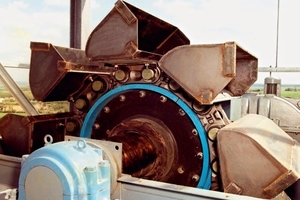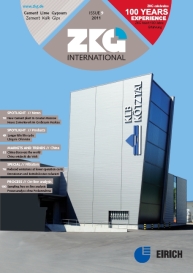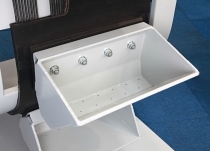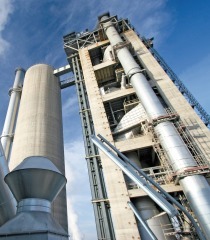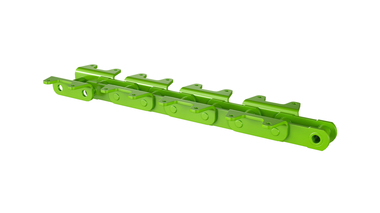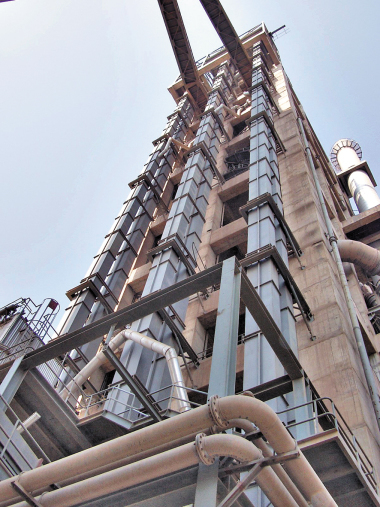Belt and central chain bucket elevators upgraded
In the cement industry and in mining, increasingly higher vertical conveying capacities are required. Bucket elevators, which distinguish themselves by high reliability and long service life, are commonly used. But both conventional belt bucket elevators and central chain bucket elevators (Fig. 1) more and more often encounter limitations in terms of conveying height and flow rate. The intralogistics specialist BEUMER offers its innovative heavy-duty bucket elevators in these cases. This new technology also makes it possible to alter existing bucket elevators, permitting greater conveying heights, higher conveying capacity and less wear.
Elevating machines (Fig. 2) like belt bucket elevators are indispensable links in the production processes of the cement industry. They are used, for example, to lift fine materials of light specific weight to great heights. Chain bucket elevators, on the other hand, transport mostly coarse, heavy material. They are very robust and able to withstand high temperatures. But both belt and central chain bucket elevators have disadvantages and often no longer can meet the demands made today in many cement mills and mines. In more and more instances, conveying capacities of over 2000 t/h with center distances in excess of 60 m are strived for. The tendency in these industries is towards ever larger grinding plants, for example with high-pressure roller mills and vertical mills. In the case of heat exchangers, owing to the increasing oven outputs raw meal bucket elevators with capacities of 800 to 900 t/h and a conveying height of up to 200 meters often are required. These are demands which neither conventional belt bucket elevators nor conventional central chain bucket elevators can meet. With its heavy-duty technology BEUMER has developed a solution which can get bucket elevators into shape to handle these growing market requirements.
Overcoming limitations
In the past, belt bucket elevators were limited by a maximum particle size of the material being conveyed. This is because the conventional bucket mounting results in a gap of about 25 mm between bucket and belt. Larger particles get stuck in this gap. This quickly results in belt damage when the belt runs around the tail pulleys. For this reason, materials with particle sizes exceeding 25 mm are transported by central chain bucket elevators. A further disadvantage of conventional belt bucket elevators is their maximum tensile load: conventional belts only can be loaded to maximum 2,500 N/mm2.
Central chain bucket elevators also have limitations. The chains permit a higher tensile load, but as the conveying height increases, the overall weight of chain, buckets and transported material reaches the breaking limit of the chain. This restricts the conveying height to 60 meters at most. Given a specific flow volume and the strongest chain, the maximum conveying height decreases as the specific weight of the material being conveyed increases. Two-strand chain bucket elevators then are used. Another drawback of central chain bucket elevators is their service life. Though identical with that of belt bucket elevators if used for materials that have little abrasive action, it is much shorter in the case of strongly abrasive materials.
Heavy-duty technology convincing
With its new heavy-duty technology, BEUMER has developed belt bucket elevators which are insensitive to large particles. Systems equipped with this technology can convey materials with a particle size of 120 mm as well as strongly abrasive materials – without wear. The reason: owing to the new bucket geometry there is no more gap between belt and bucket. The result is that coarse matter cannot get caught anymore during the scooping and filling process. The buckets are mounted absolutely firmly to the back of the belt by means of segments and screws. Additionally, the new bucket shape ensures smoother running and thus less generation of noise. Depending on the material being transported the buckets can be fitted with rubber bottoms or the bucket elevator base with a movable floor. And if explosive materials are conveyed, all components are available in an ATEX version. Depending on the requirements, the buckets feature contactless, continuous monitoring for off-track running.
A belt that resists high loads
Together with ContiTech, the belt conveyor systems manufacturer headquartered in Northeim in Lower Saxony, BEUMER developed a new steel wire belt with a tensile strength of 3300 kN/mm2. The life of the belt is appreciably longer at high operating temperatures; at low temperatures mechanical wear and tear predominates. This belt has twice the useful life of a chain. Bucket elevators fitted with this belt are a clear improvement over central chain bucket elevators when used for strongly abrasive materials like clinker, ores or blast furnace slag. They are thus also suited for vertical and high-pressure roller mills. If need be they can convey more than 2000 t/h – with center distances of more than 150 m.
Established technology
The heavy-duty belt bucket elevators in the meantime have become established in the market. Building materials manufacturer Lafarge, for instance, modernized its existing belt bucket elevator for the transport of ballast material at its facility in the town of Wössingen, near Karlsruhe, in the Baden region. A process change had resulted in a larger particle size for the material, which repeatedly became jammed between bucket and belt, causing substantial frictional wear. At first, the building materials manufacturer wanted to replace the existing belt bucket elevator with a chain bucket elevator. But after thorough consultation with the BEUMER specialists only the belt and buckets were renewed applying the heavy-duty technology. The system is used to feed material with particle sizes of up 80 mm and up to six percent moisture into a raw mill. The capacity is now 800 t/h
For Dyckerhoff in Lengerich BEUMER converted a central chain bucket elevator into a heavy-duty belt bucket elevator. It too is used to feed material with particle sizes of up 80 mm at a moisture content of 18 % into a raw mill. With the updated system the plant now transports 500 t/h.
For the Indian cement manufacturer Manigarh Cement, BEUMER modernized a central chain bucket elevator that transports materials with particle sizes up to ten millimeters and three-percent moisture for roller press recirculation. For this task the existing central chain bucket elevator was converted using the heavy-duty technology. The conveying capacity is 750 t/h.
www.beumer.com

